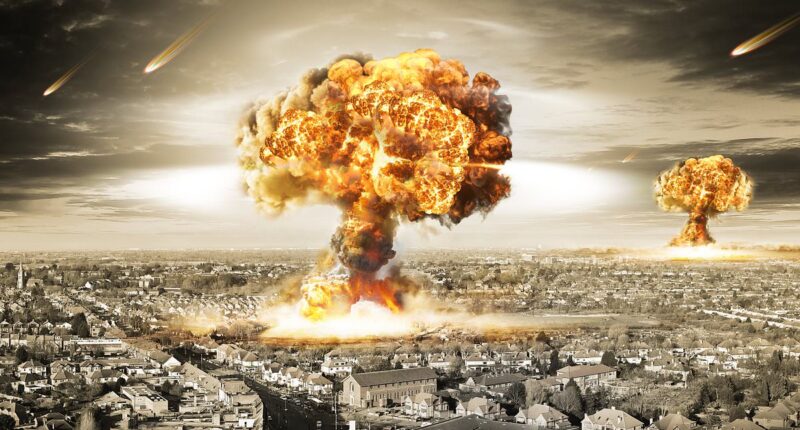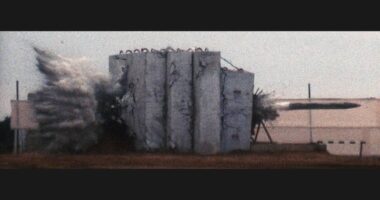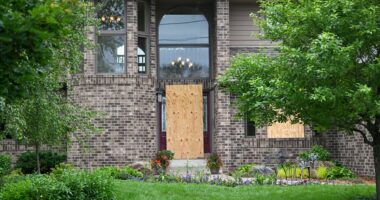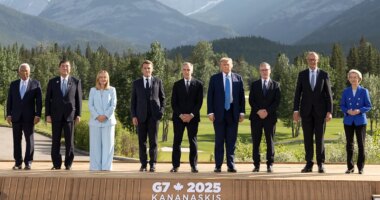There is increasing concern about the potential for a global nuclear conflict as tensions rise between key nations such as the US, Israel, Iran, and Russia. Leaders from these countries have been issuing strong warnings, raising fears of a possible escalation.
Recent reports indicate that President Donald Trump is considering supporting Israel’s military actions against Iran and pushing for Iran to surrender unconditionally. Experts caution that such a move could lead to a large-scale international war with severe consequences.
The heightened rhetoric and military positioning have prompted worries that a nuclear confrontation could be on the horizon. With the situation becoming more serious, Americans are increasingly worried about the potential of a nuclear attack on US territory.
A recent investigative report explored this worst-case scenario, painting a grim picture of the devastation that would follow.
The projections are chilling as tens of millions could perish within minutes as nuclear warheads target major metropolitan areas.
The immediate aftermath would bring massive fireballs capable of vaporizing entire city blocks, crippling infrastructure, contaminating water sources, and plunging survivors into a toxic, ash-covered landscape.
Experts warn that the global death toll could rise into the billions by the end of the first week, triggering a nuclear winter that would drastically cool the planet.
Agriculture would collapse, ecosystems would be disrupted, and the world could regress into a pre-industrial state marked by famine, radiation sickness, and the collapse of modern civilization.

The US, Israel, Iran, and Russia have all warned that a catastrophic war could be nearing as the crisis in the Middle East reaches a breaking point

Reports suggest President Donald Trump is prepared to back Israel’s military campaign against Iran. Pictured are firefighters working to extinguish a blaze after a missile launched from Iran struck Tel Aviv, Israel
Iran’s Supreme Leader, Ayatollah Ali Khamenei, said in a statement read by a television presenter on Wednesday that his country will not accept Trump’s call for an unconditional surrender.
‘This nation will not surrender to anyone in the face of imposition,’ he said in his first televised comments since Israel launched its surprise attack on Friday.
Russia has also entered the crisis, warning the US against even thinking about supporting Israel’s attacks on Iran.
Deputy Foreign Minister Sergei Ryabkov said on Wednesday that direct US military assistance to Israel could radically destabilize the situation in the Middle East.
As the risk of nuclear war grows with each passing day, investigative journalist Annie Jacobsen has laid out a horrific timeline of what would happen in the days, months and years after America is nuked.
In her book, Nuclear War: A Scenario, she features exclusive interviews with world-leading scientists and nuclear winter experts.
Those experts warned that forests and cities would burn uncontrollably, rivers and lakes would be frozen and poisoned by rotten corpses and radiation.
The few humans who did survive would revert to hunter-gatherers as agriculture collapses, while blinded, sterile survivors fight for scraps in the ruins.

The book is a fictitious scenario that envisions North Korea firing missiles at the US. After detecting the launch, the US responds by initiating its own nuclear attack by sending missiles over Russia and into North Korea. Pictured is America’s newest nuclear ‘gravity bomb’
The experts describe how, in the days following the launch of multiple nuclear weapons around the globe, radioactive soot would fill the air for months, causing temperatures in the US to plunge by roughly 40 degrees Fahrenheit, making farming impossible.
By the time the smoke clears, the ozone layer would be so depleted that the sun’s rays would cause deadly burns.
Experts predict a global nuclear war would see 360 million people dead almost instantly after the bombs hit – but Jacobsen’s book makes it clear that these fatalities would be just the beginning. Her sources say five billion would die in the first 72 minutes alone.
‘Most won’t make it more than a few steps from where they happen to be standing when the bomb detonates,’ Jacobsen wrote. ‘They become what civil defense experts referred to in the 1950s, when these gruesome calculations first came to be, as ‘Dead When Found.”
For those who don’t die instantly, survivors face a barren land, wildfires, frozen terrains, radiation exposure, no food, widespread ruin, and disease.

A nuclear war would destroy cities and towns, crushing buildings and large structures and creating wildfires
Minutes after nuclear bombs launch: The US is crippled
Jacobsen wrote about a fictitious scenario that envisions North Korea firing intercontinental ballistic missiles (ICBMs) at the US.
After detecting the launch, the US responds by initiating its nuclear attack by sending missiles over Russia and into North Korea.
Russia, an ally of the North Koreans, then orders a nuclear attack on the US and allied nations.
Thousands of huge fireballs begin to hit American cities and towns, and in each location, buildings and monuments collapse, and asphalt melts.
Cities are obliterated. Power grids and nuclear plants melt down, cutting off electricity and energy, and releasing radioactive materials into the air.
Tens of millions of people die almost instantly, and the US is crippled.
Hours after ICBMs make impact: Raging fires burn forests and towns
Wildfires break out across the northern hemisphere, and nearly everything burns in America, including cities, crops, and forests. Rings of fire stretch from 100 to 200 miles from each nuclear ground zero.
Buildings are set aflame, which releases airborne toxins from their materials. Burning insulation and fiberglass spews cyanides, vinyl chloride, dioxins, and furans.
These chemicals damage organs and the nervous system, leading to cancer, neurological symptoms, and death.
Forest fires rage in the Western states, with radioactive fallout killing conifers and creating fuel for future fires.
With the water supply across the country compromised, there is nothing to fight the flames with, leaving them to burn freely across America.
Days after the attacks, Radioactive mushroom clouds fill the air
Radioactive products from mushroom clouds, including Strontium-90, iodine-131, tritium, cesium-137, and plutonium-239, poison the environment.
These damage DNA and have been linked to cancers, retinal and skin chemical burns, bleeding, coma, and death.
Whoever has lived past the initial fallout begins to die from radiation sickness and poisoning, which cause nausea, vomiting, fever, dizziness, disorientation, bloody vomit and diarrhea, internal bleeding, and infections.
The high exposure to radiation in such a short period causes the insides of people’s bodies to liquefy as their blood vessel lining decays.
The few who survive will suffer chromosomal damage, blindness, and sterility.
Weeks after nuclear war breaks out: Soot blankets the atmosphere
In the weeks following the ICBM launches, supplies of natural gas, coal in the Earth’s crust, and peat bogs – dense wetlands of decayed vegetation – are still burning uncontrollably.
As cities and forests are engulfed in flames around the world, approximately 330 billion pounds of soot is released into the upper troposphere and stratosphere – the lowest and second-lowest layers of Earth’s atmosphere, respectively.
The heavy soot blocks the sun’s rays, and the planet’s temperatures drastically fall, setting Earth up for a nuclear winter.
Months after missiles hit: Nuclear winter descends on the planet
Climatologist Alan Robock said: ‘The density of soot would reduce global temperatures by roughly 27 degrees Fahrenheit. In America, it would be more like a drop of 40 degrees Fahrenheit, slightly less near the oceans.’
The idea of ‘nuclear winter’ first came to the world’s attention in an article by scientist Carl Sagan in 1983.
The first scientific paper explaining the idea was dismissed by the Defense Department, which called it Soviet disinformation, but newer information reveals many in the nuclear weapon complex knew it was a real risk.
Scientists at the Defense Nuclear Agency wrote that there would be ‘atmospheric trauma’ and ‘serious potential for severe consequences’ after a nuclear exchange.
The sun’s warming rays are reduced by 70 percent, and temperatures plunge, with the United States and Europe among the worst-affected areas.
In Central American states, the temperature will not rise above freezing for years.
The lack of sun kills much of the planet’s vegetation and animal life.

The idea of ‘nuclear winter’ first came to the world’s attention in an article by scientist Carl Sagan in 1983
Decades after the fallout: Humans forced back to hunter-gatherers
Prolonged freezing temperatures and lack of sunlight reduce rainfall by 50 percent, killing off crops worldwide.
The surviving humans return to a hunter-gatherer state, with millions starving to death and survivors killing each other for the limited food supplies. Humans must scavenge for roots, insects, and the few sources of uncontaminated water.
Lakes are frozen under deep sheets of ice, and other water supplies are poisoned by chemicals from industrial facilities.
Years into the fallout, as the world finally unfreezes, millions of thawing corpses poison the water supplies, and survivors along coastlines find filter-feeding shellfish have been killed off by radiation or are now too radioactive to eat.
Several more years later, the soot has settled, and the ozone layer has now lost 75 percent of its shielding power. This will allow the sun’s strong rays to reach Earth without any filter, leading to deadly sunburns.
A 2021 study on ‘Extreme Ozone Loss Following Nuclear War’ predicted that levels of UV-B would become ‘hazardous to life.’
Survivors would be forced into caves and hollows to shelter.
Humans would also face plagues, with insects multiplying and thawing corpses forming a fertile breeding ground for disease.
Insects are well-placed to survive nuclear war, studies have shown, and as the world warms, insect-borne illnesses will ravage a population of humans without antibiotics or medications.
Thousands of years after nuclear bombings: All evidence of today’s civilization is erased
Albert Einstein famously said about nuclear war: ‘I know not with what weapons World War III will be fought, but World War IV will be fought with sticks and stones.’
Even as temperatures return to pre-war conditions, the humans of the future, still living a hunter-gatherer lifestyle, may never know anything about the people that came before them – the ones who met their demise at the hands of nuclear weapons.
Jacobsen said they may never discover any trace of today’s civilization, and all knowledge of the past will be gone.
‘With time, after a nuclear war, all present-day knowledge will be gone. Including the knowledge that the enemy was not North Korea, Russia, America, China, Iran, or anyone else vilified as a nation or a group,’ the author wrote.
‘It was the nuclear weapons that were the enemy of us all. All along.’
















